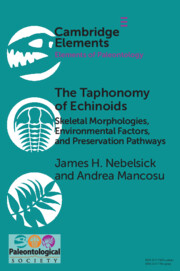Element contents
The Taphonomy of Echinoids
Published online by Cambridge University Press: 21 September 2021
Summary
- Type
- Element
- Information
- Series: Elements of PaleontologyOnline ISBN: 9781108893411Publisher: Cambridge University PressPrint publication: 21 October 2021
References
- 11
- Cited by

